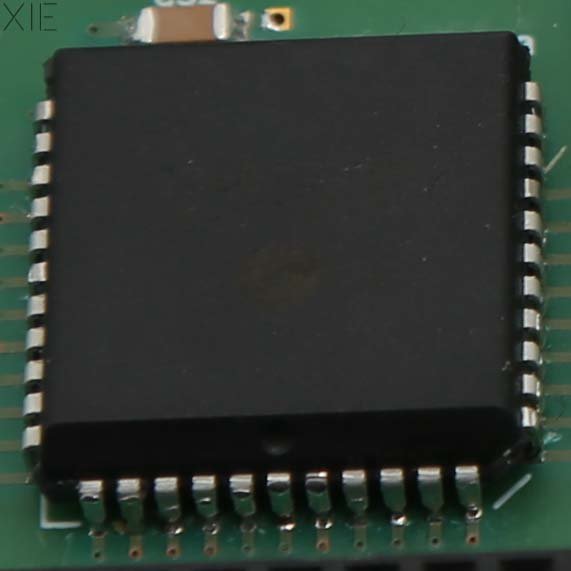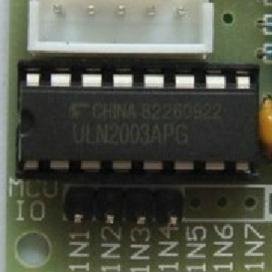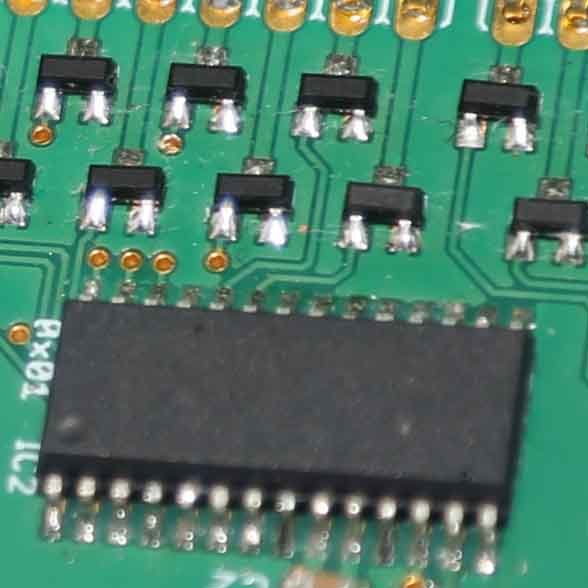IC drivers for Nixie Tubes
How to drive the cathodes of Nixie Tubes
To control a Nixie Tube and display its characters the desired cathode must be tied to a ground potential. This will create the glowing discharge on the connected cathode inside the Tube. For achieving this, there are multiple options. This article will present the most common ways and rate them.
Information and Rating:
The driving circuits we will look at are rated with the following points to give a fast and easy overview about them. All ratings are based on a simple 6-digits Nixie Tubes Clock with numbers 0-9 (60 cathodes total), no DP or Columns separators in it. Also the values are calculated for a direct-drive system, not a multiplex system!
- Difficulty: Level of skills needed to make driving circuit to work (hardware and software).
- Price: Average Cost to drive 6 Nixie Tubes (without the Tubes itself).
- Availability: Where the components can be bought and ho easily.
- PCB-Pads: Number of all PCB pads which result in solder-joints that have to be made!
- Control-Pins: Number of pins that are necessary to send control signals to the drivers.
- Discrete Drive: The driver circuit can be used without a microcontroller and can be used with standard logic family IC’s.
1. Dedicated Nixie Driver IC (7441, 74141, K155ID1 etc
In a time when Nixie Tubes where a common electronics product, there was also a need for a appropriate drivers for it. A BDC-Input to decimal decoder with high voltage output, the “7441” or “74141” with the corresponding manufacturer code (SN74141, DM74141, NTE74141 and following), was the most common driver. The difference between the 7441 and 74141 are only on the BCD-Input range, but both models operate in the same way. Of course, there where also a russian analogs that operate the same way, these where the “K155D1” and “KM155ID1”. By now these part are obsolete and not manufactured anymore, so these IC’s are only available on auction platforms or surplus electronic stores. The IC are easy to use, it can be used with or without a microcontroller and are mostly fair-priced. Plenty of circuits and resources can be found online for biulding the Clock. 6 IC’s are needed for 6 Tubes, resulting in 24 Control pins (6 x 4bit-BCD). For the use with a microcontroller a port expander is recommended. The IC’s come in a DIP-16 package (plastic or ceramic) and there are a few rare “flat-dip” versions of the russian K155ID1.

| Difficulty | Easy |
| Price: | ~ 6$ for 6pcs |
| Availability: | Ebay or Surplus |
| PCB-Pads: | 6 x 16 = 96 |
| Control-Pins: | 6 x 4 = 24 |
| Discrete Drive: | Yes |
2. Modern HV-driver IC (Microchip HV-Series)
Even today, some applications like special printing devices create a need for driver IC with high voltage outputs. The company Supertex (then Microchip) is a manufacturer of such special IC’s. A few ICs of their HV-Series can perfectly drive Nixie Tubes and provide a space efficient and modern solution. The majority of these IC’s come with 32 outputs that can sink voltages from up to 220V to up to 300V, and are mainly just high-voltage shift registers that work (and can be chained) the same way as low-voltage shift registers (595 type). The HV5122/HV5222 are the cheapest 32-bit types and can operate at up to 225V. A micrcontroller is neccessary to operate with this drivers, since a clock and data lines must be provided. Coding the 64-bit shifts (6 tubes) and the soldering of PLCC SMD packages requires advanced skill in hardware with software. The HV5222/HV5122 is available at the microchip stores and at electronic suppliers (Digikey, Mouser etc).

| Difficulty | Advanced |
| Price: | ~ 10$ for 2pcs |
| Availability: | Microchip,Digikey,Mouser |
| PCB-Pads: | 2 x 44 = 88 |
| Control-Pins: | 3 |
| Discrete Drive: | No |
3. Darlington drivers with clamped voltage (UL2003)
Some darlington transistor arrays can sink voltages up to 50V, which is not enough to supply Nixie voltages, but by clamping the voltage a driving circuit can be achieved. One of these drivers is the UL2003. This array has diodes from each output to a common pin. This common pin can be connected to ground via a zener-diode to prevent the array from destruction by overvoltage. The IC is broadly available at electronics suppliers and auction sites. There also may be a lot of similar devices that can do the same. The UL2003 comes in a 16-DIP or SOIC package but only has 7 ouputs. To drive 6 Tubes, there are nine IC’s needed, resulting in 63 control pins, since each ouput needs a separate input. The UL2003 can be used with or without a microcontroller and plenty circuits and sample codes are available broadly.

| Difficulty | Normal |
| Price: | ~ 5$ for 9pcs |
| Availability: | Most electronic distributors |
| PCB-Pads: | 9 x 16 = 144 |
| Control-Pins: | 60 |
| Discrete Drive: | Yes |
4. Direct drive with transostors or mosfets
One possibility is to use a transistor or mosfet for each cathode, and then send a control signal to the corresponding mosfet or transistor. This can be done by a microcontroller or discrete logic, but requires 60 Mosfets or Transistors. Most Transistors need also a base resistor to prevent damage. This circuit is not recommend for Nixie Clocks, it only should be considered when only a few cathodes need do be driven (like +/- Tubes) or for Columns separators neon bulbs, or in some cases for starter-projects or testing.

| Difficulty | Easy |
| Price: | 5-15$ for 60pcs |
| Availability: | Most electronic distributors |
| PCB-Pads: | 60 x 3 = 180 |
| Control-Pins: | 60 |
| Discrete Drive: | Yes |
Gra & Afch Nixie Clocks
We here at Gra & Afch offer a variety of parts for Nixie Clocks.
As well as Ready-to-Use assembled Clocks, Cases and DIY KITs that are presented in a separate sections in our shop.
And you can come visit it and look for yourself anytime: Spare parts, Nixie Tubes, Nixie Clocks without Cases, Nixie Clocks in Cases, DIY KITs for Nixie Clocks, Cases for Nixie Clocks.

